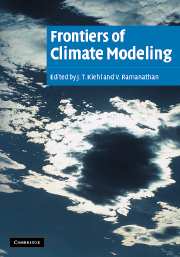Book contents
- Frontmatter
- Contents
- Preface
- List of Contributors
- Acknowledgments
- 1 Overview of climate modeling
- 2 Climate-change modeling: a brief history of the theory and recent twenty-first-century ensemble simulations
- 3 Energy-balance climate models
- 4 Intrinsic climatic variability: an essay on modes and mechanisms of oceanic and atmospheric fluid dynamics
- 5 The radiative forcing due to clouds and water vapor
- 6 A model study of the effect of Pinatubo volcanic aerosols on stratospheric temperatures
- 7 Unresolved issues in atmospheric solar absorption
- 8 Cloud feedbacks
- 9 Water-vapor feedback
- 10 Water-vapor observations
- 11 New frontiers in remote sensing of aerosols and their radiative forcing of climate
- 12 Cloud–climate feedback: lessons learned from two El Niño events
- 13 Runaway greenhouses and runaway glaciations: how stable is Earth's climate?
- Glossary
- Plate section
3 - Energy-balance climate models
Published online by Cambridge University Press: 12 August 2009
- Frontmatter
- Contents
- Preface
- List of Contributors
- Acknowledgments
- 1 Overview of climate modeling
- 2 Climate-change modeling: a brief history of the theory and recent twenty-first-century ensemble simulations
- 3 Energy-balance climate models
- 4 Intrinsic climatic variability: an essay on modes and mechanisms of oceanic and atmospheric fluid dynamics
- 5 The radiative forcing due to clouds and water vapor
- 6 A model study of the effect of Pinatubo volcanic aerosols on stratospheric temperatures
- 7 Unresolved issues in atmospheric solar absorption
- 8 Cloud feedbacks
- 9 Water-vapor feedback
- 10 Water-vapor observations
- 11 New frontiers in remote sensing of aerosols and their radiative forcing of climate
- 12 Cloud–climate feedback: lessons learned from two El Niño events
- 13 Runaway greenhouses and runaway glaciations: how stable is Earth's climate?
- Glossary
- Plate section
Summary
Introduction
As discussed in Chapter 1, energy-balance climate models are important tools for studying Earth's climate. Energy-balance climate models (EBCMs) have been used in studies of climate change for more than a quarter of a century. Some papers can be found even before that, but the widespread use of these simple models was made popular by the nearly simultaneous appearance of the papers by Budyko (1968) and Sellers (1969). A review of these and other early works was presented in North et al. (1981). The purpose of this chapter is to introduce these models in the modern context, justifying their usefulness in certain situations without hiding their limitations. We also introduce stochastic versions of the models and some recent applications of them.
The EBCMs attempt to model Earth's surface-temperature field T (r, t), where r is a point on the spherical surface and t is the time, by the constraint of energy conservation for individual columns of the Earth–atmosphere system. For each infinitesimal horizontal area element consider an ideal geometric column containing matter extending from roughly the tropopause to just beneath the solid Earth's surface, or to the bottom of the oceanic mixed layer, depending on location. The collection of all such columns covering Earth make up the system. It is assumed that the energetic indices of a column can be unambiguously labeled by the temperature at the surface (the column changes its temperature ‘rigidly’ from top to bottom). This is the first of a series of idealizations made in formulating the model. There are many fluxes of heat into and out of an individual column (now a box).
- Type
- Chapter
- Information
- Frontiers of Climate Modeling , pp. 52 - 72Publisher: Cambridge University PressPrint publication year: 2006
- 3
- Cited by



